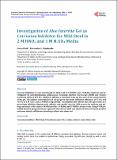| dc.contributor.author | Lucas, Paul | |
| dc.contributor.author | Machunda, Revocatus | |
| dc.date.accessioned | 2023-09-12T14:41:41Z | |
| dc.date.available | 2023-09-12T14:41:41Z | |
| dc.date.issued | 2016-01-15 | |
| dc.identifier.uri | http://dx.doi.org/10.4236/jmmce.2016.41004 | |
| dc.identifier.uri | https://dspace.nm-aist.ac.tz/handle/20.500.12479/1986 | |
| dc.description | This research article was published by Scientific Research in 2016 | en_US |
| dc.description.abstract | Corrsion inhibition of Aloe lateritia gel for Mild steel in 2 M HNO 3 and 1 M H 2 SO 4 solutions was in-
vestigated by potentiodynamic polarization, Scanning electron microscopy (SEM) and Foutier
transform infrared (FT-IR). Inhibition efficiency increased with the increase of the concentration
of the gel. The optimal concentration of the gel gives maximum inhibition efficiency of 77.4% and
70.3% in 1 M H 2 SO 4 and 2 M HNO 3 respectively. Polarization plots shows that, the gel works as a
mixed type inhibitor altering both cathodic and anodic reaction. SEM proves the uniform and pit-
ting corrosion at the surface of Mild steel in 1 M H 2 SO 4 and 2 M HNO 3 respectively. Using FT-IR po-
tential function groups from pure gel and some stretch shift was observed from corrosion product
and some stretch shift from corrosion products was observed | en_US |
| dc.language.iso | en | en_US |
| dc.publisher | Scientific Research | en_US |
| dc.subject | Corrosion Inhibitor | en_US |
| dc.subject | Mild Steel | en_US |
| dc.subject | otentiodynamic Polarization | en_US |
| dc.subject | Sulfuric Acid | en_US |
| dc.subject | Nitric Acid | en_US |
| dc.title | Investigation of Aloe lateritia Gel as Corrosion Inhibitor for Mild Steel in 2 M HNO3 and 1 M H2SO4 Media | en_US |
| dc.type | Article | en_US |

